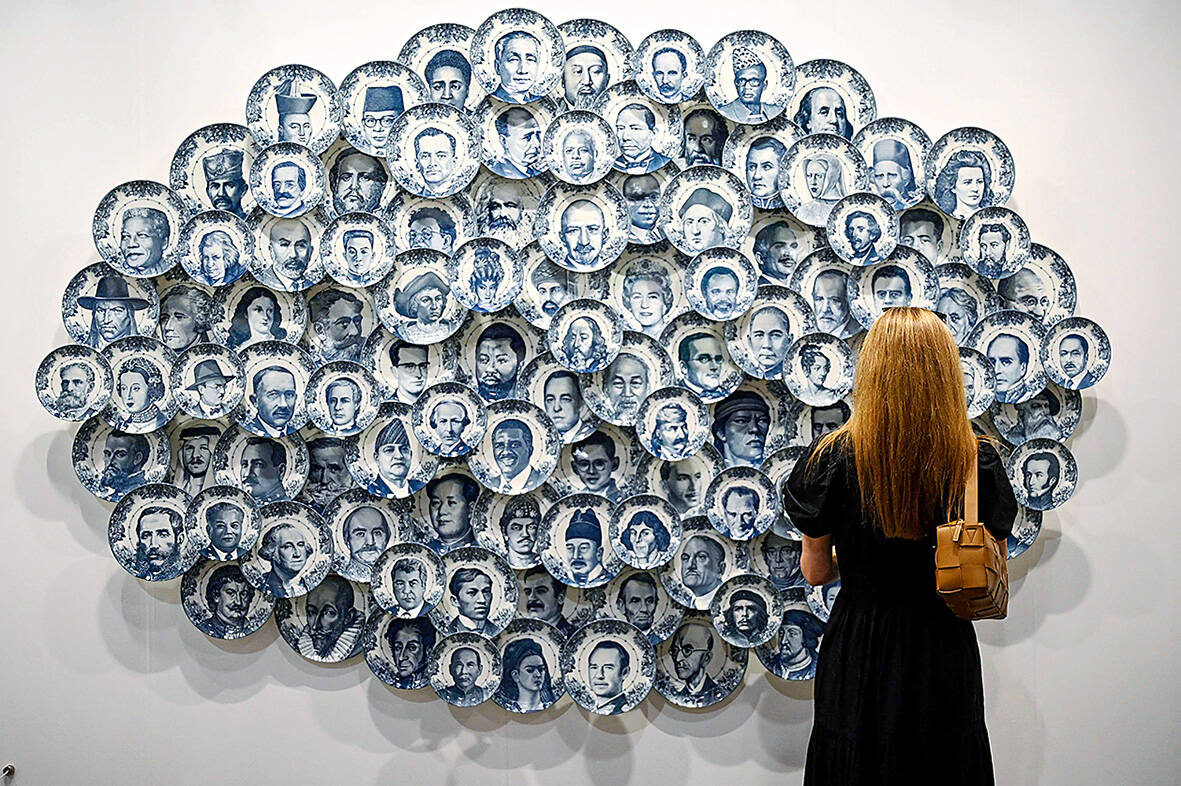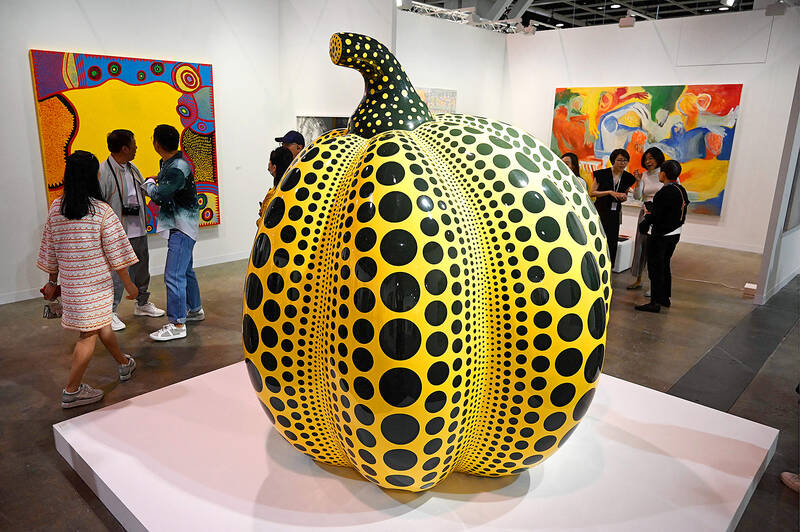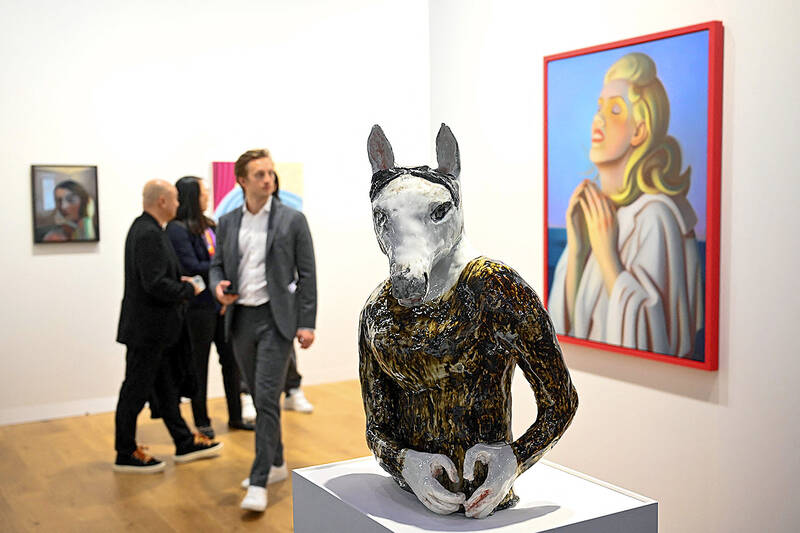As thousands of visitors streamed through a Hong Kong exhibition hall and deals were struck for works by Picasso and Yayoi Kusama, art collectors celebrated the Asian financial hub’s return to its bustling heyday.
The scenes at Hong Kong’s Art Basel fair last week had not been seen since 2019, with a crackdown on pro-democracy protests and pandemic restrictions in the intervening years radically transforming the city.
More than 86,000 visitors poured through the halls of the fair, reflecting a return to pre-pandemic numbers, with reported sales of more than US$98 million, double those of 2019, according to organizers.

Photo: AFP
Among the biggest deals were a 1964 Picasso sold for US$5.5 million, as well as works by Japanese artist Kazuo Shiraga (US$5 million) and a strikingly surreal “pumpkin” by Kusama (US$3.5 million), according to reported sales figures released by the fair.
The energy at Art Basel reflected the increasing importance of the Asian art market, said organizers, who told AFP that their work was not impacted by the city’s national security law.
“Asia has been the fastest developing art market in the world,” said Angelle Siyang-Le, director of Art Basel Hong Kong.

Photo: AFP
For some, however, the success of the fair was not indicative of a healthy art scene.
Hong Kong once held a reputation as a bastion of free speech within authoritarian China, but the national security law (NSL) imposed in 2020 after widespread and sometimes violent pro-democracy protests has criminalized dissent, including in art.
“I don’t think just because the sale(s) number at Art Basel is good (it) means ‘Hong Kong is Back,’” said Kacey Wong (黃國才), a dissident artist who left the city in 2021 due to the crackdown.

Photo: AFP
“The NSL created self-censorship amongst the creative industry. Instead of exploring social/political topics, artists dive more into decorative colorful subjects to avoid the NSL’s red line(s).”
Last week, a digital artwork that contained the names of jailed Hong Kong democracy protesters on a billboard in the heart of the city was taken down.
COMPETING CITIES
For art collectors, however, the crackdown has not seemed to matter.
“So far we feel like there’s been no impact, we are confident that we will be operating the same way as before,” Siyang-Le said.
Foreign artists said they were happy to take advantage of Hong Kong’s market.
“It’s an opportunity to get more (exposure),” said M Pravat, a New Delhi-based artist who was exhibiting at Art Basel.
Years of harsh pandemic restrictions in Hong Kong have seen other Asian cities, including Seoul and Singapore, vie to supplant it on the international art scene. Thierry Ehrmann, head of market analysis firm Artprice, said Hong Kong remained well-placed to compete.
“Hong Kong retains the advantage of a well-structured market, with the presence of the major international players... which translates into a considerable lead in terms of sales revenue,” he said.
One of Hong Kong’s main advantages for collectors is its lack of customs duties, value-added taxes or inheritance taxes on works of art.
’EXTRAORDINARY’ POTENTIAL
China is the world’s second-largest art market, after the US, with sales set to recover from a dip related to pandemic controls that have now been lifted, according to Artprice. The world’s three main art auction houses are expanding their presence in Hong Kong, where art auctions netted more than US$1.16 billion last year.
Sotheby’s was projected to generate 12 percent of its global art auction turnover in Hong Kong last year, compared with 13 percent for Phillips and eight percent for Christie’s.
Last year, Sotheby’s signed a lease for a 2,230 square-meter space in the heart of Hong Kong’s Central district, which boasts some of the most expensive rents in the world.
“The potential is extraordinary,” said Alex Branczik, chairman for Modern and Contemporary Art in Asia for Sotheby’s. “The acquisition of this space really shows that we are here to stay”.
NEW CLIENTS
Today, the auction house has as many bidders in Asia as it does in North America.
“These bidders in Asia are fundamentally important to our sales rooms in London, New York, Paris and so forth,” said Branczik.
One-third of Sotheby’s Asia bidders last year were new clients, and two-thirds of new clients worldwide were from the region. Artists not in the city’s art elite, however, have had more trouble making a living.
“In my career, I try not to rely on selling my works to galleries as a way of living, they are simply not reliable,” said Wong, the dissident, who now lives in Taiwan and says he “dare not” exhibit his work in Hong Kong.
Auction houses and collectors, he said, steer clear of “sensitive artists and works.”
“For them these types of works are landmines.”

This month Taiwan received a brutal Christmas present as the Chinese Nationalist Party (KMT) passed all three of its desired amendments, making recalls of elected officials more difficult, gutting the Constitutional Court and altering the budgetary allocations to local governments. The nation at present has no ultimate authority to determine the constitutionality of government actions, and the local governments, largely controlled by the KMT, have much greater funding. We are staring into an abyss of chaos. The amendments to the Act Governing the Allocation of Government Revenues and Expenditures (財政收支劃分法), if they become law (as of this writing President William Lai

Dec. 30 to Jan. 5 Premiering on Jan. 4, 1956, Xue Pinggui and Wang Baochuan (薛平貴與王寶釧) unexpectedly packed theaters for the next 27 days. Taiwan’s first 35mm Hoklo-language (commonly known as Taiwanese) movie beat out the top Hollywood blockbuster, Land of the Pharaohs, and the Mandarin-language Peach Blossom River (桃花江) in box office sales, kicking off a craze that lasted until around 1970. More than 800 Hoklo-language films were made despite government attempts to promote Mandarin. The Chinese Nationalist Party (KMT) owned the nation’s three major production houses, mostly creating Mandarin films filled with anti-communist messages and patriotic propaganda. But most

Charges have formally been brought in Taiwan People’s Party (TPP) Chairman Ko Wen-je’s (柯文哲) bribery, corruption and embezzling of campaign funds cases. Ko was briefly released on bail by the Taipei District Court on Friday, but the High Court on Sunday reversed the decision. Then, the Taipei District Court on the same day granted him bail again. The ball is in dueling courts. While preparing for a “year ahead” column and reviewing a Formosa poll from last month, it’s clear that the TPP’s demographics are shifting, and there are some indications of where support for the party is heading. YOUNG, MALE

When the weather is too cold to enjoy the white beaches and blue waters of Pingtung County’s Kenting (墾丁), it’s the perfect time to head up into the hills and enjoy a different part of the national park. In the highlands above the bustling beach resorts, a simple set of trails treats visitors to lush forest, rocky peaks, billowing grassland and a spectacular bird’s-eye view of the coast. The rolling hills beyond Hengchun Township (恆春) in Pingtung County offer a two-hour through-hike of sweeping views from the mighty peak of Dajianshih Mountain (大尖石山) to Eluanbi Lighthouse (鵝鑾鼻燈塔) on the coast, or